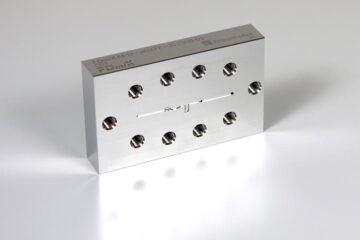High tech imaging tells the tale of plaque from the inside out

Not all plaque – the fatty substance that builds up in arteries – is the same and some plaque types are more likely to rupture, which can trigger the formation of a blood clot and a blocked artery. An experimental spectroscopic/imaging technique can provide exact information about plaque components that can help guide treatment, researchers reported at the American Heart Association’s Scientific Sessions 2005.
“Time-resolved laser-induced fluorescence spectroscopy or TR-LIFS can be used to accurately identify plaque with these dangerous characteristics, while the plaque still lines the walls of vessels,” said lead researcher Laura Marcu, Ph.D., director of biophotonics research at the Cedars-Sinai Medical Center and associate professor at the University of Southern California in Los Angeles.
The laser pulse heats up or “excites” molecules in the plaque while researchers measure the “time” that molecules stay in the excited state. This time is specific to different types of molecules, which helps researchers determine the “exact composition of the plaque.”
When plaque has a thin, fibrous layer or cap over a large core area of lipids, it’s most vulnerable to rupture, which can result in the blood supply to a part of the heart or brain being blocked.
Researchers tested the TR-LIFS device by identifying the type of plaque found in the carotid arteries, the main blood supply for the brain. They measured 353 plaque areas in the carotid arteries of 50 patients who were scheduled to undergo carotid endarterectomy, a procedure in which the carotid arteries are opened and plaque is surgically removed.
After the endarterectomy was done, pathologic examination was used to categorize the plaques as early (minimal thickening), fibrotic (collagen-rich lesions), or high-risk (necrotic core with a thin cap). These results were compared to those the researchers received when using the fluorescence spectroscopy to categorize the same plaques as early, fibrotic and high risk.
Results indicated the technique was 97 percent effective in identifying high-risk lesions.
“TR-LIFS was tested in patients undergoing endarterectomy because it allowed us to assess the plaque inside the artery and then compare our findings with the pathology of the specimens that had been surgically removed,” Marcu said. “The study confirmed that our approach is feasible. The new method identifies the high-risk plaques, those with large lipid pools and inflammatory cells, factors contributing to weakening of the plaque. Plaques that do not display these characteristics are of less risk to the patient.”
The initial results with TR-LIFS encouraged the researchers to develop an intravascular catheter-based system that would permit minimally invasive evaluation of arteries.
“The goal is to develop a TR-LIFS probe that can be used to assess plaque in vessels in the heart,” Marcu said. “That’s where TR-LIFS could be important. Plaque composition could dictate the best intervention: bare metal stenting, use of drug-eluting stents, balloon angioplasty or even bypass surgery to restore blood flow to the heart.”
Media Contact
More Information:
http://www.heart.orgAll latest news from the category: Health and Medicine
This subject area encompasses research and studies in the field of human medicine.
Among the wide-ranging list of topics covered here are anesthesiology, anatomy, surgery, human genetics, hygiene and environmental medicine, internal medicine, neurology, pharmacology, physiology, urology and dental medicine.
Newest articles

For microscopic organisms, ocean currents act as ‘expressway’ to deeper depths
New research shows how tiny plant-like organisms hitch a ride on ocean currents to reach darker and deeper depths, where they impact carbon cycling and microbial dynamics in the subtropical…

FDmiX: Fast, robust series production of nanoparticles
Nucleic acid-based medications such as mRNA vaccines are opening up new therapeutic approaches. These active ingredients must be enclosed inside nanoparticles to ensure that they get to where they are…

Sensor measures oxygen content of breath
Oxygen saturation in the blood that is either too low or too high can cause physical harm or even death. This is why patients’ oxygen concentraions are monitored continuously in…





















